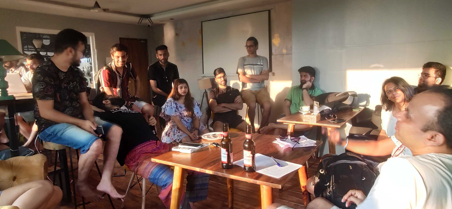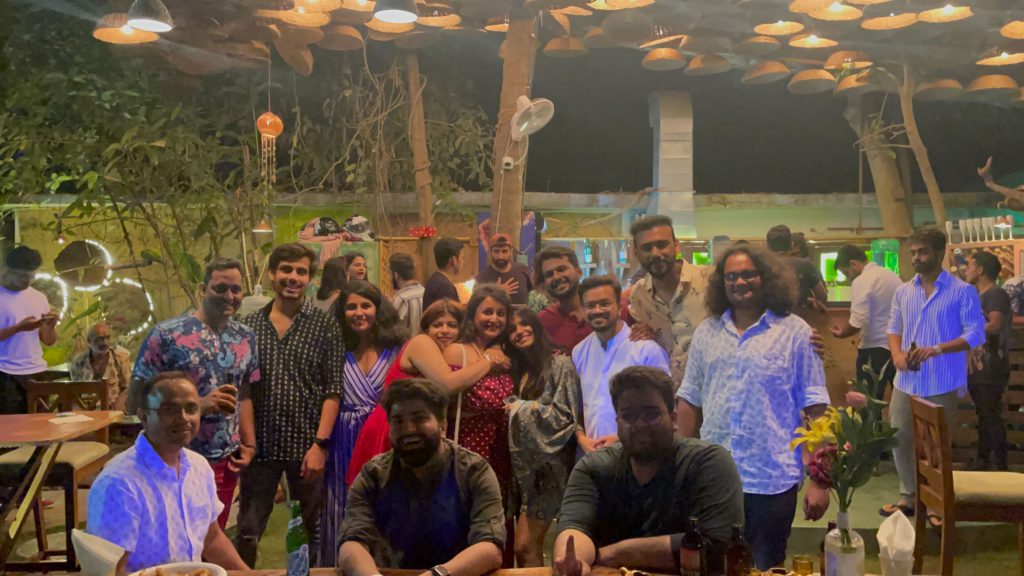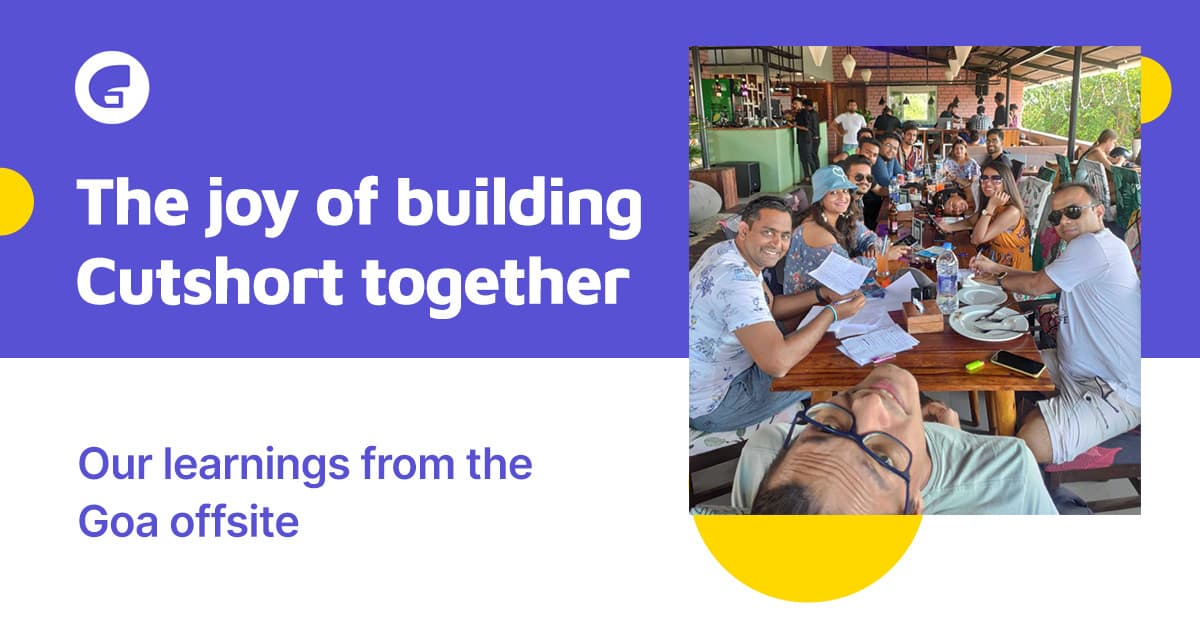Charting our ambitious future during the Goa offsite.
A village can raise a child. But when it comes to building a company, even a company could feel overwhelmed. This is why we built Cutshort on the shoulder of giants and never fooled ourselves into thinking that it’s an individualistic effort. Where we are is a result of perseverance of many and it’s only fair that people who got us here show us the way to the future too.
Recently, we had a team-wide offsite in Goa where the idea was to relax, rejuvenate and reconnect with each other beyond the work settings. However, it also proved to be a fertile ground for some ambitious ideas for our collective future.
Over lunch, music, and a few chilled drinks, our team discussed what they want Cutshort to be in the future – from the big orbital shifts to the smaller tweaks in our product.
It was exciting to hear so many new ideas, visions, and perspectives from people who build Cutshort every day. This kind of ownership is the stuff of dreams for any company and we made full use of it by not just hearing out all these. Wonderful ideas but also integrating them into our long-term vision and roadmaps.
Sounds very Ubuntu-esque? Let’s dive into it.
Being a partner, not just a provider
“While we do focus on guiding fresher candidates through what fits them best, I think we also need to guide candidates who are professionals, have been around for 3-4 years and have reached a threshold”, said Sweta.
The suggestion of helping people find a right fit for them, despite being professionals in a field, gained undivided acceptance. Noel added how helping people find a fit for them goes beyond just finding a job. “Finding a good fit isn’t about just upskilling either, it’s a larger question where you look into (and) what makes life better for you”, she added.
In addition to helping people find their right careers, it’s a bigger responsibility of seeing them through it, Manish affirmed.
“There are two types of people – the ones who are clear about what they want, and the ones who are still figuring it out. There are many people out there who have the skills but are still figuring things out for themselves. At Cutshort, we can try to guide them with this throughout. Also, even when someone is hired, they might want to shift fields, or expand their knowledge. What if Cutshort enables people to learn more and explore more?”, he said.
Expanding our horizons
While we have the choicest pool of candidates and companies continuously engaging with each other, the team felt that there’s a universe of untapped potential that’s ripe for us to capture. Dev from our team elaborated on this and advised that Cutshort should be more proactive in outreach and find innovative ways to attract the best candidates and companies.
“Having outreach programmes for early professionals where we talk about scope and sectors of work can increase our talent pool, and help people find what they need and how to approach it. We also need to increase our brand on social media, with the right marketing, we could also address demand and supply gaps”, Dev said.
Abel was quick on his feet to note that while someone he bumped into knew of Cutshort, they didn’t know exactly what we do. “If we build a social space where someone can talk about their jobs, opportunities, skills, and more, it could fuel our marketing. People would then have experience of being on Cutshort and it can increase the people we attract”, he said.
This not only found favour across the team but also became an important inflexion point for a lot of conversations around Cutshort’s roadmap.
Interesting questions arise – do we prioritize creating value through product or spend more time communicating that value through marketing? What are the companies we want to invite? What are the ways in which we can deliver value to professionals who aren’t necessarily looking for jobs? Do we keep serving the Indian market or go global with our offerings? And so on.
While Parth discussed his vision of international expansion for Cutshort, Prakahar asked the team to look inwards. “We need to be the best in India before we jump for International expansion. While currently we’re helping startups get top talent, we should also get talent across to enterprises. Mass recruiters like IBM or Cognizant don’t always look out for what startups do in people, and we need to plan to get across to them too”, he concluded.
And most importantly, it ties into our core values of creating value for our stakeholders – even if they don’t always bring us revenue.

Building bridges
It’s in this spirit that Siddhant pointed out that we should focus on helping both candidates and companies realize that the work culture is now radically evolving and money isn’t everything.
“Jobs are seen as very transactional – you work 9 hours a day and get paid an X amount at the end of the day. While it gets people to work, it doesn’t sustain value over time. We need to find ways to make jobs motivating for people. One thing that works is creating value. When people can see the impact of their work before themselves, they’re likely to want to create more impact. Even when it comes to people, we need to encourage the mindset that jobs aren’t just for salaries, but also about the value you add”, he said.
At the same time, there’s plenty of advice going around – even when you don’t ask for it. But there’s very little valuable guidance when one’s in the need.
Anupran spoke about how there are thousands of graduates in the tech sphere who don’t know what they want to do next, and make decisions based on randm advice given by teachers, family, or friends. This creates a chohort of clueless people in the workforce – they are either clueless about what job they want, or clueless about what to do once they get the job.
“We need to address that people need guidance with their career path and skills. Currently, at Cutshort, we’re catering to people who have a great idea about these, but that isn’t the majority. Most people don’t, and to build that ecosystem, we must look at ourselves as an Ed-tech space too. We need to 1) provide mentorships, 2) make a platform for career guidance, and 3) stick to what we’re doing currently. What Cutshort does right now, needs to be supported by 1 and 2 for a holistic, end-to-end way of changing how people perceive jobs”, he added.
Goa and offsites are two words that go together so seamlessly, you’d think they’re made for each other. Now we know, no one really wants to ‘work’ on an offsite, let alone discuss existing problems and solutions. But at Cutshort, we’ve been lucky enough to have people who bring energy wherever they go (especially in Goa).
The suggestions shared by our team are currently getting their foundations laid. Who knows, you’ll see a few of these manifest real soon. Our business and product raodmap now has a problem of plenty – and we aren’t complaining.
Here’s to you, Cutshorters!






